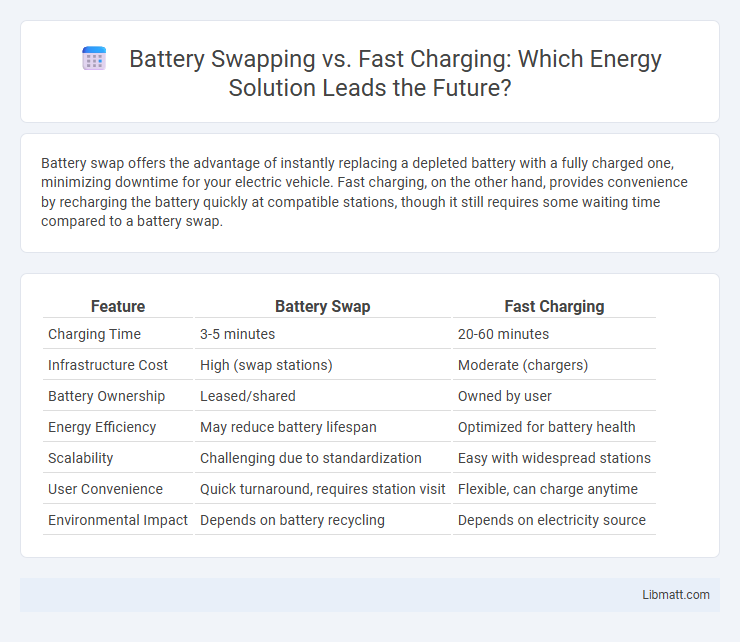Battery swap offers the advantage of instantly replacing a depleted battery with a fully charged one, minimizing downtime for your electric vehicle. Fast charging, on the other hand, provides convenience by recharging the battery quickly at compatible stations, though it still requires some waiting time compared to a battery swap.
Table of Comparison
| Feature | Battery Swap | Fast Charging |
|---|---|---|
| Charging Time | 3-5 minutes | 20-60 minutes |
| Infrastructure Cost | High (swap stations) | Moderate (chargers) |
| Battery Ownership | Leased/shared | Owned by user |
| Energy Efficiency | May reduce battery lifespan | Optimized for battery health |
| Scalability | Challenging due to standardization | Easy with widespread stations |
| User Convenience | Quick turnaround, requires station visit | Flexible, can charge anytime |
| Environmental Impact | Depends on battery recycling | Depends on electricity source |
Introduction to EV Charging: Battery Swap vs Fast Charging
Battery swap offers a rapid solution by replacing depleted EV batteries with fully charged ones, minimizing downtime to just a few minutes. Fast charging, on the other hand, uses high-power chargers to replenish the battery directly, often reaching 80% charge within 20-40 minutes depending on the charger type and battery capacity. Your choice between battery swap and fast charging depends on factors like infrastructure availability, convenience, and charging speed preferences.
How Battery Swapping Works
Battery swapping involves rapidly replacing a depleted electric vehicle (EV) battery with a fully charged one at a dedicated station, eliminating wait times associated with traditional charging. This method relies on standardized battery packs and automated systems to streamline the exchange process, typically completed within minutes. Your EV can continue its journey almost uninterrupted, making battery swapping a practical alternative to fast charging for enhanced convenience.
Fast Charging Technology Explained
Fast charging technology involves delivering high power to EV batteries through advanced charging protocols like CCS or CHAdeMO, enabling rapid energy transfer within minutes. It relies on battery management systems to regulate voltage and temperature, preventing degradation and ensuring safety during high-rate charging sessions. Innovations such as silicon carbide (SiC) inverters and ultra-fast DC chargers continue to reduce charging times while maintaining battery health.
Key Differences Between Battery Swap and Fast Charging
Battery swap technology replaces a depleted electric vehicle battery with a fully charged one within minutes, eliminating wait time, while fast charging delivers high power through specialized chargers to quickly replenish the battery but still requires 20-40 minutes per session. Battery swapping demands standardized battery packs and infrastructure for seamless operation, whereas fast charging relies on advanced power electronics and robust grid connections to support rapid energy transfer. The key differences lie in their operational model: battery swap emphasizes instant battery exchange and infrastructure logistics, whereas fast charging focuses on high-speed energy delivery and battery thermal management.
Pros and Cons of Battery Swapping
Battery swapping offers the advantage of ultra-fast energy replenishment by exchanging a depleted battery for a fully charged one, significantly reducing downtime compared to fast charging stations. However, the cons include the high infrastructure costs for establishing swapping stations, compatibility issues across different electric vehicle models, and the logistical complexity of maintaining a large inventory of charged batteries. Your choice depends on whether you prioritize convenience and speed over the broader compatibility and infrastructure availability that fast charging currently offers.
Advantages and Limitations of Fast Charging
Fast charging significantly reduces the time required to recharge electric vehicle batteries, allowing you to resume driving with minimal delay compared to traditional charging methods. However, frequent fast charging can accelerate battery degradation due to increased heat and stress on battery cells, potentially reducing overall battery lifespan. Infrastructure for fast charging is expanding rapidly but still faces challenges such as high installation costs and uneven availability across regions.
Infrastructure Requirements and Deployment
Battery swap infrastructure demands standardized battery designs and extensive networks of swap stations equipped with robotic systems, enabling rapid battery exchanges within minutes. Fast charging deployment requires high-capacity power grids and widespread installation of ultra-fast chargers capable of delivering 150 kW or more, often necessitating grid upgrades to manage the electrical load. Your choice between the two should consider the current availability of compatible stations and local energy infrastructure readiness to support seamless electric vehicle operation.
Impact on Battery Life and Vehicle Performance
Battery swap systems preserve battery life by avoiding frequent high-power charging cycles that fast charging entails, reducing thermal stress and degradation. Fast charging, while convenient, can accelerate battery wear due to increased heat and faster chemical reactions within the battery cells, potentially diminishing capacity over time. Vehicle performance remains stable with battery swaps since drivers receive fully charged, well-maintained batteries, whereas fast charging might temporarily reduce performance if the battery management system limits output to prevent damage.
Cost Comparison: Swap Stations vs Fast Chargers
Battery swap stations generally require higher upfront infrastructure investment due to complex mechanical systems and inventory management for multiple battery packs, while fast charging stations have relatively lower setup costs focused on high-capacity power delivery. Operating expenses of swap stations include battery maintenance and inventory turnover, which can lead to increased long-term costs compared to fast chargers that primarily incur electricity costs and minimal hardware upkeep. Cost efficiency depends on usage frequency and scale, with fast chargers being more economical for low-to-moderate demand and swap stations potentially optimizing cost through high-volume, rapid turnaround in fleet or commercial applications.
Future Trends and Industry Adoption
Battery swap technology is gaining traction among fleet operators and urban mobility services due to its rapid turnaround time, enabling vehicles to be back on the road within minutes. Fast charging is widely adopted for passenger EVs with advancements pushing charging speeds beyond 350 kW, reducing wait times to under 15 minutes for an 80% charge. Industry trends highlight integration of battery swap stations with smart grid systems and increased investment in ultra-fast charging infrastructure to support mass-market EV adoption.
Battery Swap vs Fast Charging Infographic

 libmatt.com
libmatt.com